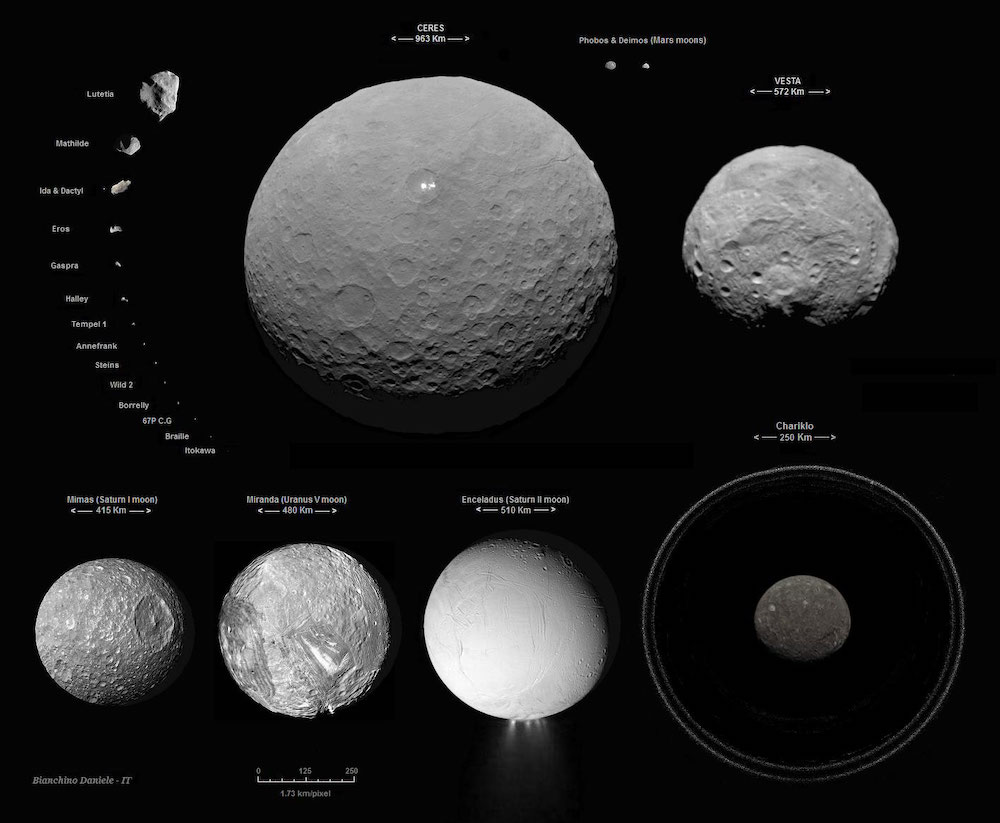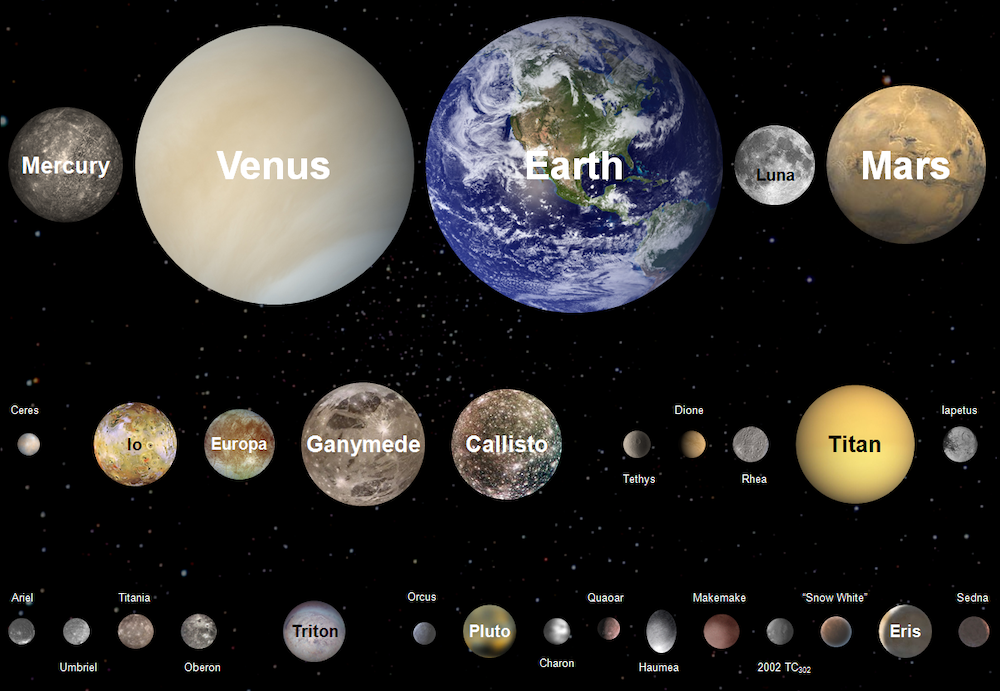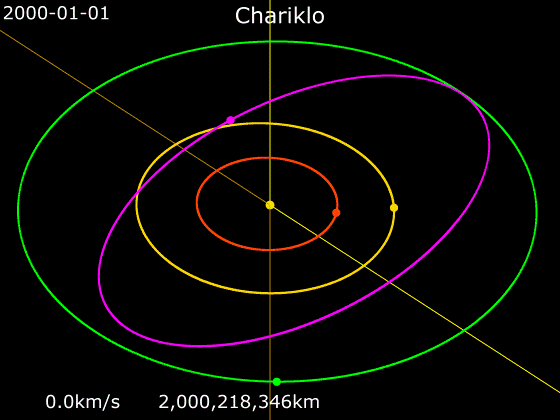October 01, 2019
Chariklo and the Importance of Reading the WHOLE Page Before Linking it
I was curious about that ringed asteroid/dwarf planet they found between Uranus and Saturn a while back. Chariklo is one of several asteroids in that region between Uranus and Saturn which have collectively been named the Centaurs. The objects in this small group are named after centaurs from Greek mythology and as there aren't many of those, any non-Centaur spouses/children from when the myths implied that the achievement "hybrid vigor" was unlocked...still they are likely to run out of names from Greek Mythology and will soon have to go to other sources.

Ms. Shianus by エルセン(Elsen?)

Ms. Shianus by エルセン(Elsen?)
Etymology aside, these objects don't represent a large field like the Main Belt, the Jovian Trojans, or Hildas, but are thought to be a few objects from the Kupier Belt tossed sunward like Triton and Pluto/Charon. The largest of these, Chariklo, (named after Chiron's wife) had caused some confusion due to uncertainty about its size and readings that indicated it was either big and icy or small and surprisingly not so. It turned out that the Chariklo is a largely spherical object with an icy ring system that may imply two or more shepherd moons as well.
Not enough is known about this object to know if it will ultimately qualify as a Dwarf Planet (it would have to be in hydro-static equilibrium) but there's a chance that it might. It's certainly at the low end of the scale of such things as can be seen here.....

Because Ceres is not a common frame of reference, the below picture may be helpful.

Besides the general coolness factor of the rings, one thing appears curious from the perspective of a layman with a mere Bachelor of Arts degree. The rings were discovered in part because when viewed front on the object appeared to be an icy object, when viewed ring edge on the moon appeared to be ice free. Now, "ice free" might mean largely anhydrous like Psyche, or just covered in regolith like Ceres. If the former, Chariklo might be something even more interesting. If all it's water is baked out then this thing might be a differentiated object like Vesta and Psyche, with all the potential for mineral wealth that that would imply.
As of now I have not learned anything more along those lines.
However, while looking, I did encounter the exact opposite of learning. Well almost. In my search I blundered onto this website and very nearly used it as a reference hyperlink...after all it linked to space.com and had a nice overview of the object...the etymology of its name, and it then went on to discuss where the object can be seen in the sky at various times of the year which might be useful if one somehow has a ridiculously powerful telescope as this is a very dark object, (though the rings might be visible to some very well equipped amateur astronomers if one knows where to look).
Alas, this positional information was in reference to which HOUSES the object is in when viewed from Earth because the discovery of this object fills in some of the gaps in the predictive powers of...astrology.
Oh Lord.
Yes, the cray-cray is strong with this link. The author manages to tie in many of the cast and crew of Star Trek, Dr. Who, The Outer Limits and various other Sci-Fi authors to being born under the sign of this object, because this space-rock being linked...somehow...to forward thinking people is obviously linked to those involved in science fiction. Obviously.
Obviously.
Actually, there is a tremendous amount of research that went into this page. There is the equivalent of four typed pages that catalog when people of note were born when this asteroid happened to be in a certain arbitrary location when viewed from the Earth*.
There's an awful lot of numbers and charts.
So, (checks) I appear to be a Capricorn. If I were to apply this websites knowledge practically, what conclusions could be drawn about me?

Indeed.
But wait.
This stupid actually gets worse.
Three out of the first five pages that came up on Chariklo in a web search were in fact astrology pages. None of them were the Space.com page that the Astrology page linked to.
The algorithms that are deciding who gets to speak and what is a credible source can't tell the difference between astrology and astronomy.
This is why we can't have nice things.
We're doomed! DOOMED!
Of course, in a few million years Chariklo might be too, since it's likely to eventually join the Saturnian or Uranian system....perhaps catastrophically.

Not enough is known about this object to know if it will ultimately qualify as a Dwarf Planet (it would have to be in hydro-static equilibrium) but there's a chance that it might. It's certainly at the low end of the scale of such things as can be seen here.....

Because Ceres is not a common frame of reference, the below picture may be helpful.

Besides the general coolness factor of the rings, one thing appears curious from the perspective of a layman with a mere Bachelor of Arts degree. The rings were discovered in part because when viewed front on the object appeared to be an icy object, when viewed ring edge on the moon appeared to be ice free. Now, "ice free" might mean largely anhydrous like Psyche, or just covered in regolith like Ceres. If the former, Chariklo might be something even more interesting. If all it's water is baked out then this thing might be a differentiated object like Vesta and Psyche, with all the potential for mineral wealth that that would imply.
As of now I have not learned anything more along those lines.
However, while looking, I did encounter the exact opposite of learning. Well almost. In my search I blundered onto this website and very nearly used it as a reference hyperlink...after all it linked to space.com and had a nice overview of the object...the etymology of its name, and it then went on to discuss where the object can be seen in the sky at various times of the year which might be useful if one somehow has a ridiculously powerful telescope as this is a very dark object, (though the rings might be visible to some very well equipped amateur astronomers if one knows where to look).
Alas, this positional information was in reference to which HOUSES the object is in when viewed from Earth because the discovery of this object fills in some of the gaps in the predictive powers of...astrology.
Chariklo aspects seem to be prominent in individuals who take a step into the future. It may be through science (Pierre Curie, who studied the various types of energies, had a close Chariklo conjunct Sun...the greatest source of energy for this planet; Alexander Graham Bell, who studied ways to communicate with the deaf and who invented the telephone, had a close Chariklo conjunct Mercury....planet of communication).
Oh Lord.
Yes, the cray-cray is strong with this link. The author manages to tie in many of the cast and crew of Star Trek, Dr. Who, The Outer Limits and various other Sci-Fi authors to being born under the sign of this object, because this space-rock being linked...somehow...to forward thinking people is obviously linked to those involved in science fiction. Obviously.
Obviously.
Actually, there is a tremendous amount of research that went into this page. There is the equivalent of four typed pages that catalog when people of note were born when this asteroid happened to be in a certain arbitrary location when viewed from the Earth*.
There's an awful lot of numbers and charts.
So, (checks) I appear to be a Capricorn. If I were to apply this websites knowledge practically, what conclusions could be drawn about me?

Indeed.
But wait.
This stupid actually gets worse.
Three out of the first five pages that came up on Chariklo in a web search were in fact astrology pages. None of them were the Space.com page that the Astrology page linked to.
The algorithms that are deciding who gets to speak and what is a credible source can't tell the difference between astrology and astronomy.
This is why we can't have nice things.
We're doomed! DOOMED!
Of course, in a few million years Chariklo might be too, since it's likely to eventually join the Saturnian or Uranian system....perhaps catastrophically.

Green=Uranus Yellow=Saturn Unlikely Pink=Chariklo
*The third large object orbiting an unremarkable green dwarf in a big empty bubble in the Orion arm of The Milky Way Galaxy, one of what is provincially known as The Local Group, a cluster of Galaxies which is somewhat removed from the apparent center of Lainekia.
*The third large object orbiting an unremarkable green dwarf in a big empty bubble in the Orion arm of The Milky Way Galaxy, one of what is provincially known as The Local Group, a cluster of Galaxies which is somewhat removed from the apparent center of Lainekia.
Posted by: The Brickmuppet at
10:15 PM
| Comments (3)
| Add Comment
Post contains 902 words, total size 9 kb.
Posted by: Rick C at Wed Oct 2 09:08:36 2019 (Iwkd4)
2
I am reminded of a very old Non Sequiter daily comic, where a professor is welcoming his new course-worth of students to Astronomy, and one of them asks about the difference between astronomy and astrology. The reply of 'Lots and lots of math' clears the room.
As in many/most things, Wiley and Non Sequiter was channeling real life with that one.
As in many/most things, Wiley and Non Sequiter was channeling real life with that one.
Posted by: cxt217 at Wed Oct 2 16:44:04 2019 (LMsTt)
3
A select few astrology mavens can actually turn out useful, if you are a deep enough classics nerd to need info about Greek and Roman astrology. Some crazy astrology guy did some really beautiful translations of Latin and Greek astrological works, which was helpful for the paleoastronomy people.
Especially since it's weird to have to explain, "Of course I don't believe this, and I'm just translating it," whereas nobody has to explain their position that there are obvious deficiences in an early science or agriculture text.
Of course, it's much more entertaining to read footnotes written by an ag guy for an ag book, or a veterinarian for a veterinary book. "We still do this" and "this is crap" footnotes often directly parallel the format of the original old book!
Especially since it's weird to have to explain, "Of course I don't believe this, and I'm just translating it," whereas nobody has to explain their position that there are obvious deficiences in an early science or agriculture text.
Of course, it's much more entertaining to read footnotes written by an ag guy for an ag book, or a veterinarian for a veterinary book. "We still do this" and "this is crap" footnotes often directly parallel the format of the original old book!
Posted by: Suburbanbanshee at Tue Oct 15 14:44:38 2019 (sF8WE)
40kb generated in CPU 0.0152, elapsed 0.0943 seconds.
71 queries taking 0.084 seconds, 360 records returned.
Powered by Minx 1.1.6c-pink.
71 queries taking 0.084 seconds, 360 records returned.
Powered by Minx 1.1.6c-pink.









